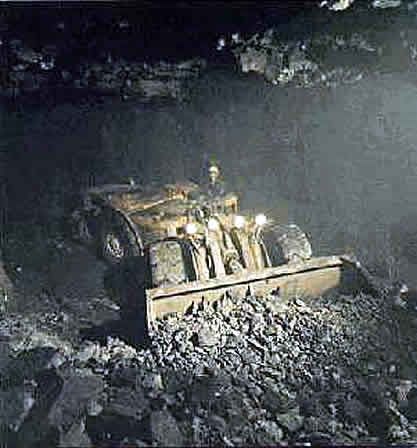
ENGINEERING AND PLANNING
MINING PRACTICE
The Granduc deposit consisted of a number of separate orebodies designed as "A"; "Dl" and "82"; "C", which was the largest and in which a minor zone designated "Ch" (the "h" being for hanging wall) was providing much of the production tonnage at the time of Western Miner's mine tour; and "F" which is under development and which lies to the north beyond a granitic dike. The "82" zone merges with the "C" zone in the southern portion of the mine and in turn the widening "C" zone roughly parallels the " A " zone as they continue to the north.
Scoop tram removing the copper ore after it has been drilled and blasted.During mining in the "81" and "82" orebodies there would be a tendency to bring down too great a proportion of dirt fines from the surface. Therefore, on the steep hillside overlooking the Leduc glacier, the overburden was being bulldozed to remove these fines. The work was being done by Caterpillar D-8 tractors, with removal of the waste and dumping by Scooptrams.
Mineralization throughout the ore zones had been found to be generally uniform in grade and composition and is primarily chalcopyrite and pyrrhotite with associated pyrite and minor amounts of magnetite, galena, and sphalerite. A great deal of study went into the methods to be used in mining and extracting the ore, resulting in the decision to use a sub-level caving method. Later use of the open-stope method is not discounted depending on the ability of the stopes to support the rock.
The sub-level caving decision was made following a visit to Sweden where a study was made of the same method being used. Sub-level intervals, after being initially set at 40 feet reverted to 30 feet principally due to the flattening of the "C" orebody in the upper levels and the fact that it was felt that the 30- ft. interval offered a better opportunity for control.
